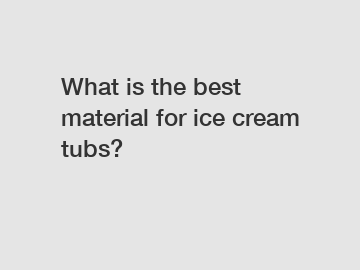Jan. 23, 2024
Packaging & Printing
Link to HONOKAGE
Ice cream is undoubtedly one of the most beloved treats around the globe. From classic vanilla and chocolate to exotic flavors like lavender honey or matcha green tea, there's something for everyone's taste buds. But have you ever wondered how this delicious dessert is preserved and presented in those tubs we all know so well? The choice of material for ice cream tubs plays a crucial role in maintaining its quality and enticing appearance. In this blog, we will explore the best materials that ensure optimum preservation, while also taking into account important factors such as sustainability, ease of use, and creative packaging.
1. Plastic: The Classic Choice:

Plastic, particularly polypropylene (PP) or high-density polyethylene (HDPE), has long been the preferred material for ice cream tubs. Its popularity can be attributed to its exceptional durability, low cost, and its ability to withstand freezing temperatures. Plastic tubs efficiently seal in the freshness, preventing unwanted moisture and freezer burn while preserving the delightful taste of your favorite ice cream. Moreover, plastic allows for a wide range of creative designs, enabling manufacturers to captivate consumer attention with visually appealing packaging.
2. Paperboard: A Sustainable Alternative:
As environmental concerns continue to gain prominence, the demand for sustainable packaging options has risen. Paperboard, made from a renewable resource, offers an eco-friendly alternative for ice cream tubs. Although not as widely used as plastic, paperboard containers boast commendable insulating properties and can be easily recycled. With the right coating and structural design, paperboard tubs can effectively withstand freezing temperatures, guaranteeing optimal preservation.
3. Biodegradable Materials: Respecting Nature:
To further address environmental concerns, some manufacturers are turning to biodegradable materials, such as cornstarch-based plastics or bagasse (sugarcane pulp) for ice cream tubs. These materials have shown promise in terms of eco-friendliness, but their use in the ice cream industry is still limited due to their relatively higher costs and potential limitations in preserving the product's quality during long-term storage.
4. Metal: A Forgotten Gem:
While not as commonly used today, metal tubs were popular in the past, and some manufacturers still employ this material for ice cream preservation. Metal offers extraordinary insulation and durability, ensuring optimum temperature control, especially during transportation. However, metal containers' limited design options and high costs have reduced their prevalence despite their exceptional functional qualities.
5. Hybrid/Composite Materials: Innovating with Technology:
With advancements in material science and technology, composite materials have emerged as fascinating alternatives for ice cream tubs. These materials combine the best characteristics of different substances to offer enhanced preservation, insulation, and aesthetic appeal. For instance, blending plastic and aluminum can create tubs that offer superior temperature control while providing a visually striking appearance. Hybrid materials allow for versatility in design while addressing the need for effective preservation.
Conclusion:
When it comes to selecting the best material for ice cream tubs, several factors must be taken into account, including quality preservation, sustainability, creative packaging, and cost-effectiveness. While plastic tubs remain the go-to choice for their durability and versatility, paperboard containers offer a more sustainable option. Biodegradable materials show great potential but have not fully penetrated the market due to cost considerations. Metal and hybrid/composite materials, although less prevalent, boast exceptional functional qualities that should not be overlooked.
In the end, choosing the right material for ice cream tubs is a balance between preserving the mouthwatering flavors and textures of this delightful dessert and ensuring that our packaging choices align with our commitment to environmental sustainability. As technology developments continue to pave the way for innovative solutions, the future may see a shift towards materials that seamlessly combine functionality, creativity, and eco-friendliness. After all, enjoying ice cream is not just about indulging in a sweet treat; it's also about cherishing a sustainable and responsible experience.
If you want to learn more, please visit our website.
For more information, please visit ice cream container in 2L volume.
If you are interested in sending in a Guest Blogger Submission,welcome to write for us!
All Comments ( 0 )